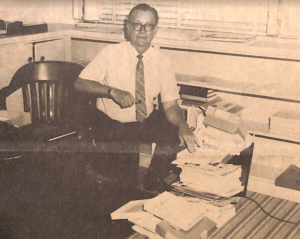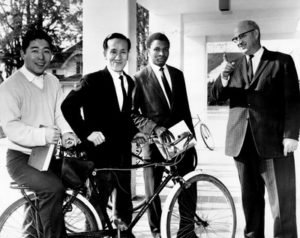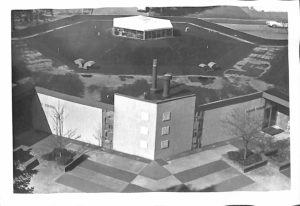
As George Fox College struggled to eliminate debt yet again and prepare for another attempt at accreditation, two men were hired who would contribute immensely to the recovery of the college: Professor of Religion Arthur O. Roberts and President Milo Ross. These two men emphasized the college’s goals of gaining support from the Friends church and increasing academic strength.
Ross was primarily interested in theological and missions work, not college administration. Thus, many were surprised by the choice to elect him as president. Ross had been a successful pastor, but he had only a bachelor’s degree and no previous training in college administration. However, he was determined to do his best. Ross is well remembered by many for his servant’s heart and all that he did throughout campus.
Fred Gregory fondly remembers President Ross and his hard work throughout campus. He recalls a day when President Ross spent his free time building and tending to planters outside of Minthorn Hall. Gregory said this memory was a perfect description of President Ross’s willingness to serve others.
With the arrival of a new president, the college experienced a multitude of changes. The first issue to be dealt with was the mountain of debt the college faced. In the past, the college’s approach to balancing the budget was to spend as little as possible to prevent further debt. Ross envisioned a different method: using creative spending to implement more attractive programs to attract more students and donors. An outburst of activity followed. The number of available scholarships increased, faculty salaries were raised, and new majors were added. As a result of the many changes within the structure of the college, the Northwest Association of Secondary and Higher Schools accredited George Fox College on December 2, 1959. The academic reputation of the college was on the rise.

Between 1954 and 1969 the number of doctorates held by college faculty increased from one to nine. However, as a result of this emphasis on PhDs, George Fox began to lose its positive ratio of female to male faculty. Although the school had always had female faculty (three of the original seven faculty were women), the faculty ratio changed from 13 women and 8 men in the early 1950s to 5 women and 40 men by the early 1970s. During this era, it was much less common for women to earn a doctorate, and thus women were hired less often.
Fun Fact: The Lemmons Building is shaped like a water molecule

The student body increased from 122 in 1954 to 406 in 1969. There were also international students from many countries including Guatemala, Iran, Japan, Kenya and South Korea.